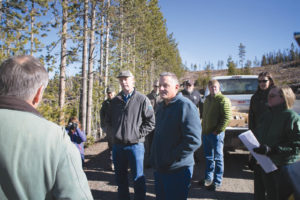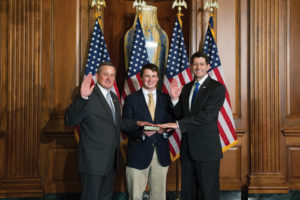
One of the few professional engineers in Congress, Republican Rep. Bruce Westerman of Arkansas pulls no punches when discussing the potential use of geosynthetics in federal infrastructure projects.
“I think geosynthetics should be part of the toolkit,” Westerman said during a phone interview with Geosynthetics magazine on May 19.
First elected to Congress in 2014 to represent the 4th District of Arkansas, Westerman previously worked for 22 years as an engineer and forester before he sought public office. During his engineering career, he used geosynthetics in projects ranging from pavement design to rehabilitating greenfields at wood products factories in his rural home district in southwestern and western Arkansas. Eleven Fortune 500 companies call the district home, and several industries that have historically used geosynthetics have operations in the district, including timber harvesting (road construction and erosion control), mining/energy (petroleum, natural gas and bromine), agriculture, construction and aviation. The 4th District is also home to two national forests and one national park; two interstate highways; and numerous state, county, municipal and gravel roads.
When asked how his background as an engineer and forester helped inform his work as a member of Congress, Westerman said, “It’s a great education to have in a lot of different areas, [as] engineers have often been called glorified problem solvers. And that’s really what engineering is about: solving problems. I think you can take that same skill set and the educational background that goes with it and apply that to solving problems in government.
“My undergraduate [degree] is in engineering but my graduate degree is in forestry,” he continued. “I joke with people sometimes that I may have the worst educational background to serve in Congress, because engineers think with logic and reason, and foresters look at long-term horizons. . . . But I think it serves me well and gives me an opportunity to have a different perspective on some of the issues that we face than members with less technical backgrounds.”
When it comes to geosynthetics, Westerman is well versed. In fact, Westerman spearheaded an effort among House members to write a Nov. 17, 2017, “Dear Colleague” letter to Secretary of Transportation Elaine L. Chao. The letter encouraged the U.S. Department of Transportation “to continue to look into the use of geosynthetic materials.”

The letter further stated, “Our nation should not miss opportunities to spur economic growth, welcome innovation and improve our global competitiveness. Greater utilization of geosynthetic materials has potential to ensure that infrastructure built under [Chao’s] watch will be constructed faster and last longer.”
The letter was endorsed by Westerman and nine of his congressional colleagues: Reps. Rick Crawford, R-Ark.; Rodney Davis, R-Ill.; Chuck Fleischmann, R-Tenn.; Garret Graves, R-La.; Frank LoBiondo, R-N.J.; Steve King, R-Iowa; David Rouzer, R-N.C.; Kurt Schrader, D-Ore.; and Randy Weber, R-Texas.
Chao wrote a positive response to Westerman and his colleagues on Jan. 17, 2018.
The initial Westerman et al. letter was a high-profile effort to encourage consideration of using geosynthetics in federal transportation projects. Westerman also made clear in his interview with Geosynthetics that he sees geosynthetics as a valuable component in many federal projects, especially pavement design.
“Assuming somebody has gone through the design process, if [geosynthetics] get used, then you’re going to have a pavement system that holds up longer,” Westerman said. “There’s tremendous benefit to that, whether you are talking about airports, roadways, interstate highways or roads going into national parks. You want those [construction projects] to hold up well, and you want to not have to [repeatedly] repair them, because there are huge costs in repairing infrastructure. You get into traffic delays, you get into the cost of repairs and there’s just a whole list of reasons why using something that gives the most bang for the buck is the best way to go.”
Westerman seems well positioned in Congress, through his service on several committees and subcommittees, to influence the inclusion of language in legislation encouraging the use of geosynthetics, when appropriate, in infrastructure projects. He serves on the Committee on the Budget; Committee on Natural Resources; Subcommittee on Federal Lands; Transportation and Infrastructure Committee; Subcommittee on Railroads, Pipelines, and Hazardous Materials; Subcommittee on Highways and Transit; and the Subcommittee on Aviation.
“As legislation moves through the Transportation and Infrastructure Committee and other committees,” Westerman said, “I’ll be keeping an eye on it to make sure they’re not playing favorites or not giving products their equal opportunity to be utilized on projects.”
Looking ahead, Westerman said, “There’s talk about a big transportation and infrastructure bill, and that is the main area where geosynthetics could be used across the country as far as legislation we’ll be passing.
“I think everybody wants to see [an infrastructure bill or bills] happen,” he added, “but the problem is coming up with the funding to make it happen. I think there will be some kind of bill passed. But the question is the order of magnitude of the bill. How [many projects] would be done? And that all comes back to funding.”
So, how can the industry advocate geosynthetics to members of Congress? Westerman shared suggestions.
“One of the best ways to educate your member of Congress is to have people from their district who are familiar with geosynthetics [meet with senators, representatives and their staffs],” he said. “I think it’s more effective when it’s someone from your district who comes in to talk with you about it. I think that’s a role engineers can play, to help educate their member of Congress on the benefits of . . . these materials.”
Westerman said educating engineers is key, “I think you also need to do a better job of educating engineers and design professionals in construction about the benefits of geosynthetic materials. I didn’t learn about them in college; I learned about them through professional engineering luncheons, where a speaker would come in and talk about geosynthetics. . . . As much time as the industry spends talking to members of Congress, they also need to schedule meetings with state departments of transportation and [with] folks in the U.S. Department of Transportation here in Washington, D.C.
“[Geosynthetics are a] tool in the tool chest and folks should . . . know that option is out there.”
 TEXTILES.ORG
TEXTILES.ORG


